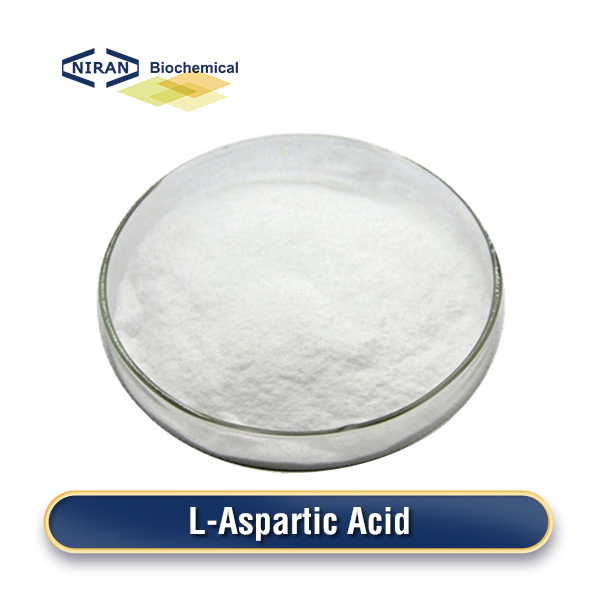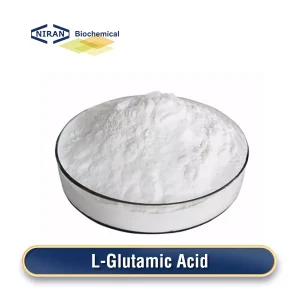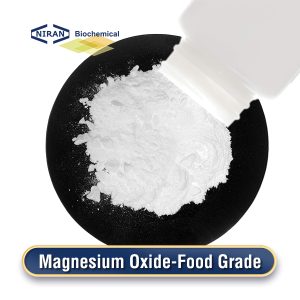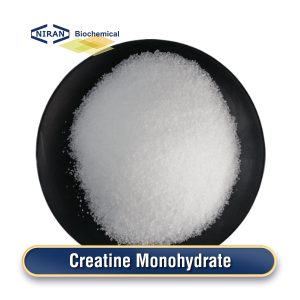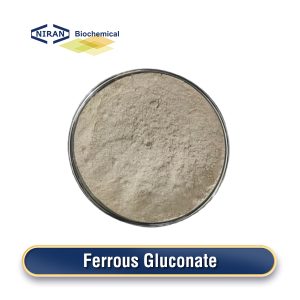What Is L-Aspartic Acid?
Known for its slightly sour taste, L-aspartic acid is an organic compound that can be used in the food industry as a flavor enhancer, regulator, and nutritional enhancer. It is soluble in boiling water, readily soluble in diluted acid, and appears as white crystals or crystalline powder.
L-aspartic acid can be prepared using two primary methods:
1. The synthesis process, which mostly uses fumaric acid, maleic acid, or their esters as raw materials, hydrolyzes them after treating them under pressure with ammonia. While racemic aspartic acid is simpler to produce, there isn’t a perfect way to divide the racemic body.
2. The fermentation process involves the addition of fumaric acid and ammonia to produce a high yield of product through the activity of enzymes. The primary industrial production process, however, only yields the high-yielding left-handed isomer.
Related Parameters:
| Items | Specification |
| Loss on drying(%) | 11.5 – 12.5 |
| Residue on ignition(%) | 0.1 Max |
| Heavy Metals(ppm) | 10.0 Max |
| As(ppm) | 1.0 Max |
| Fe(ppm) | 10.0 Max |
| pH | 4.4 – 6.4 |
| State of solution(%) | 98.0 Min |
| Cl(%) | 0.02 Max |
| NH4(%) | 0.1 Max |
| SO4(%) | 0.02 Max |
Recommended Dosage:
| Food name | Maximum usage(g/kg) |
| Beverages | 0.5-2.0 g/kg |
| Dairy products | 0.5-1.0 g/kg |
| Seasonings | 1.0-3.0 g/kg |
| Soy sauce | 1.0-2.0 g/kg |
| Meat products | 1.0-2.0 g/kg |
| Sausages | 1.0-2.0 g/kg |
| Ham | 1.0-2.0 g/kg |
| Potato chips | 0.5-1.0 g/kg |
| Biscuits | 0.5-1.0 g/kg |
| Nuts | 0.5-1.0 g/kg |
| Bread | 0.5-1.0 g/kg |
| Chocolate | 0.5-1.0 g/kg |
| Candy | 0.5-1.0 g/kg |
L-Aspartic Acid Has A Wide Range Of Uses
1. Flavor enhancer: L-aspartic acid has a certain umami taste and can be used as a flavor enhancer and flavor enhancer to enhance the overall flavor of food. It can help enhance the taste of food and make it more delicious, especially in condiments, soy sauce, ready-to-eat foods, etc.
2. Nutrition enhancer: As an amino acid, L-aspartic acid plays an important role in the human body and is an important component of protein. It can be added to food as a nutritional enhancer to provide additional amino acids and supplement the nutritional needs of the human body.
3. pH regulator: L-aspartic acid has good buffering capacity and can be used as a pH regulator in food. It helps maintain the acid-base balance of food and improves the stability and texture of food, especially in beverages, juices, candies and other foods that require pH control.
4. Preservatives and antioxidants: Food oxidation can be slowed down and its freshness and flavor can be maintained by the antioxidant qualities of L-aspartic acid. In some foods, the antioxidant effect of L-aspartic acid can reduce food deterioration and shelf life issues.
5. Promote protein synthesis: L-aspartic acid can promote protein synthesis and metabolism in the body, and has a positive effect on supporting muscle growth and repair. Adding L-aspartic acid to food can enhance the nutritional value of food, especially for athletes and consumers who need to build muscle.
User Asked Question:
Q: What is the difference between D-aspartic acid and L-aspartic acid?
A: L-aspartic acid and D-aspartic acid are two enantiomers of aspartic acid, which are mirror images in spatial structure. L-aspartic acid is the most common form in nature and is widely present in organisms, especially in proteins, as an important component of amino acids. Energy production, neurotransmitter synthesis, and amino acid metabolism all depend on it.
D-aspartic acid is less common and mainly exists in some microorganisms. Its function in organisms is relatively limited and does not participate in major physiological processes or protein synthesis. Although D-aspartic acid plays a smaller role in nature, it may have application potential in certain scientific research and drug development.
L-aspartic acid is a common flavoring, nutritional enhancer, and pH regulator used in food products and health care items. It plays an important role in various foods and beverages, helping to adjust the taste and maintain the stability of food.
D-aspartic acid has right-handed optical activity, while L-aspartic acid has left-handed optical activity. This optical property gives them different applications in analysis and synthesis. The optical properties of L-aspartic acid enable it to interact effectively with other molecules in the body, while the applications of D-aspartic acid are mainly concentrated in specific research fields.

